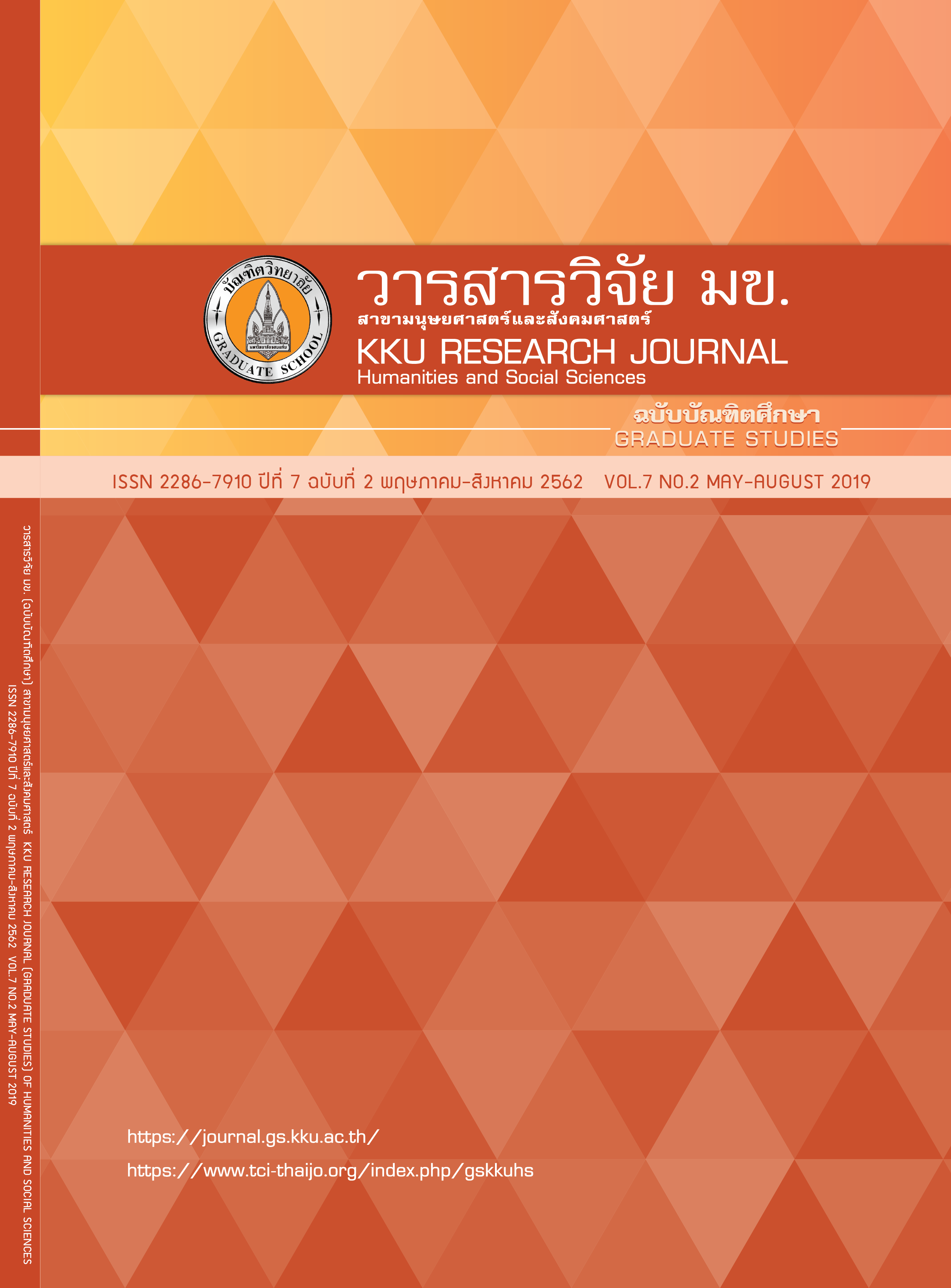ปัจจัยที่มีผลต่อความผูกพันต่อองค์กรของแพทย์ในโรงพยาบาลเอกชน ในภาคตะวันออกเฉียงเหนือ
คำสำคัญ:
ปัจจัย, ความผูกพัน, โรงพยาบาลเอกชนบทคัดย่อ
การวิจัยครั้งนี้มีวัตถุประสงค์เพื่อศึกษาถึงระดับความผูกพันต่อองค์กรของแพทย์ในโรงพยาบาลเอกชนและวิเคราะห์ปัจจัยที่มีผลต่อความผูกพันต่อองค์กรของแพทย์ในโรงพยาบาลเอกชน โดยใช้วิธีวิจัยเชิงผสม (Mixed Methods Research) ทำการเก็บข้อมูลใช้วิธีการสัมภาษณ์และแจกแบบสอบถาม กลุ่มตัวอย่างคือ ผู้บริหารและแพทย์ที่ทำงานในโรงพยาบาลจำนวน 10 คน และแพทย์ จำนวน 155 คน ข้อมูลจากแบบสอบถามนำมาวิเคราะห์ด้วยค่าสถิติพื้นฐาน และเปรียบเทียบระดับความผูกพันต่อองค์กรของแพทย์ ด้วยสถิติ t-test และ F-test และวิเคราะห์หาความสัมพันธ์ของปัจจัยที่มีผลต่อความผูกพันต่อองค์กรของแพทย์ในโรงพยาบาลเอกชน โดยหาค่าสัมประสิทธิ์สหสัมพันธ์ (Pearson Product Moment Correlation Coefficient) ผลการวิจัยพบว่า โรงพยาบาลเอกชนในภาคตะวันออกเฉียงเหนือ ส่วนใหญ่มีอายุตั้งแต่ 20 ปีขึ้นไป ลักษณะการบริหารโรงพยาบาล ประกอบด้วยผู้อำนวยการ รองผู้อำนวยการ หัวหน้าแผนกต่างๆ ส่วนใหญ่มีเครื่องมือและอุปกรณ์ทางการแพทย์ที่จำเป็นสำหรับการดูแลรักษาคนไข้พื้นฐานเท่านั้น และสัดส่วนของแพทย์บางเวลามากกว่าแพทย์เต็มเวลา ความผูกพันของแพทย์ต่อโรงพยาบาลเอกชนในด้านพฤติกรรมการปฏิบัติงาน พบว่า แพทย์ส่วนใหญ่ใช้ความรู้ความสามารถในการทำงานอย่างเต็มที่ในระดับมากที่สุด ระดับความผูกพันอื่นๆอยู่ในระดับมาก ส่วนระดับความผูกพันของแพทย์ต่อโรงพยาบาลเอกชนในด้านทัศนคติอยู่ในระดับมากทั้งหมด ในการวิเคราะห์ปัจจัยที่มีความสัมพันธ์กับความผูกพันของแพทย์ต่อโรงพยาบาลเอกชน ซึ่งประกอบด้วย 3 ด้านคือปัจจัยด้านลักษณะงาน ด้านลักษณะองค์กร และด้านลักษณะประสบการณ์ทำงาน และปัจจัยย่อยทั้งหมด 15 ปัจจัย ผลจากวิเคราะห์พบว่า ทั้ง 3 ด้านมีความสัมพันธ์กับความผูกพันต่อองค์กรของแพทย์ในโรงพยาบาลเอกชนอย่างมีนัยสำคัญทางสถิติที่ระดับ 0.01 สำหรับปัจจัยย่อยทั้ง 15 ปัจจัยมีความสัมพันธ์กับความผูกพันต่อองค์กรอย่างมีนัยสำคัญทางสถิติ แต่ระดับความสัมพันธ์ต่างกัน โดยมี 3 ปัจจัยย่อยที่มีความสัมพันธ์ในระดับสูง คือ 1)โรงพยาบาลมีเครื่องมือที่ทำให้เกิดความชำนาญ 2) การได้รับโอกาสความก้าวหน้าในการทำงาน 3) ที่ตั้งโรงพยาบาลอยู่ใกล้บ้าน แนวทางการสร้างความผูกพันต่อองค์กรของแพทย์ คือ โรงพยาบาลควรมีหน่วยงานในโรงพยาบาลที่ทำหน้าที่ดูแลเรื่องความผูกพันต่อองค์กรของแพทย์โดยเฉพาะ ควรทำโครงการสร้างความเชี่ยวชาญด้วยการส่งแพทย์ไปศึกษาและอบรมต่อเนื่องในสาขาวิชาที่แพทย์แต่ละคนถนัด ควรมีเครื่องมือที่ทันสมัย เหมาะกับความเชี่ยวชาญของแพทย์ อีกทั้งควรสร้างแผนและเส้นทางความก้าวหน้าให้แพทย์
เอกสารอ้างอิง
Form https://www.bnhhospital.com/th/; 2018.
2. Tawan Tawongsri. The Situation and Trends of Business / Industry.
Bangkok: Real Estate and Construction Business and industry research; 2016.
3. National Statistical Office. Private hospitals and private sector survey
in 2016. (Online). Founded on July 25, 2011. Form http://service.nso.go.th/
nso/nsopublish/service/survey/hospital50.pdf; 2016.
4. Nawasanan Wongprasit. A study of an employee engagement model
from the perspective of private hospital directors in Thailand. 2014; 9(1), 1-12.
5. Holmes, Henry and Suchada Tangtongtavy. Working with the Thais.
2nd ed. Bangkok: Whitelotus; 1995.
6. Porter, L.W., Steers, R.M., Mowday, R.T. and Boulian, P.V.
“Organization Commitment, Job Satisfaction and Turnover Among
Psychiatic Technicians,” Journal of Applied Psychology 1974;
59: 603-609.
7. Miner, J.B. Industrial – Organization Psychology.
The State University of New York at Buffalo; 1992.
8. Steers, R. M. & Porter, L. W. Motivation and Work Behavior.
3rd ed. New York: McGraw Hill; 1983.
9. Mowday, R.T., Porter, L.W. and Steers, R.M. Employee-Organization
Linkages : The Psychology of Commitment, Absenteesim, and
Turnover. New York : Academic Press; 1982.
10. Taro Yamane. Statistics – An Introductory Analysis.
Tokyo: John Weatherhill; 1970.
11. Taemsuk Sukwiboon. Considering the creation of a rating
scale tool for research.. Founded on July 25, 2011.
Form http://www.ms.src.ku.ac.th; 2010.
12. Cham T.H., Lim Y.M., Aik N.C , Tay A.G.M. "Antecedents of
hospital brand image and the relationships with medical tourists’
behavioral intention", International Journal of Pharmaceutical and
Healthcare Marketing 2016; 10(4): 412-431.




